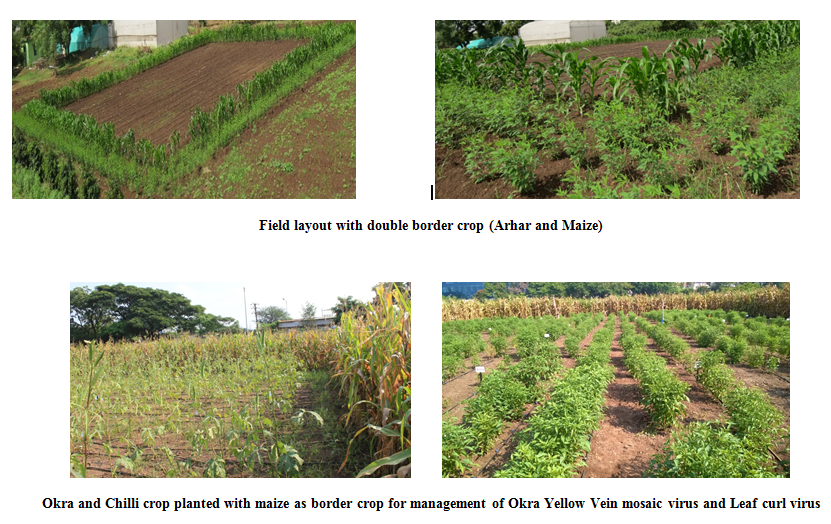Natural pest control provides a safer and more sustainable approach for managing pest populations. Insecticide sprays against the vectors are not effective in reducing virus disease because vectors transmit virus before the insecticides act to kill them. Use of a border crop to form a screen around the main crop has provided protection against several non-persistent virus diseases. Border cropping can regulate pest populations and/or limit the damage caused to the crop through the pest diversion process.
Vegetable cultivation is a part of Indian farming system, which is susceptible to several pathogenic agents, among them losses caused by viral diseases are enormous. Although, insecticidal interventions bring down the pest damage, they have led to problem of pesticide residues in fruits. Vectors have often evolved resistance to commonly used pesticides, which requires some alternative control strategies. Moreover, excessive use of pesticides led to the development of undesirable problems like destruction of natural enemies, pest resurgence, and failure of control strategies leading to outbreak of pests. Management of the viral diseases at early growth stage will reduce the yield losses as well as subsequent expenditure on vector control. Field experiments were undertaken to find out the ecofriendly pest management strategies, which is through the use border crop coupled with ecofriendly insecticides for the management of vectors/pests.
The Technique
Border/Barrier plants are a management tool based on secondary plants used within or bordering a primary crop for the purpose of disease control. An ideal plant barrier should be a non-host for the virus and the vector, but appealing to the vector landing and attractive to their natural enemies and should allow sufficient residence time to allow probing before takeoff occurs. Barrier plants act as real natural sinks for non-persistent vector transmitted viruses and have proved to be an effective crop management strategy to protect against virus infection. Use tall barrier crops like maize, sorghum etc., so as to reduce the number of vector population entering the main crop. Vector like aphids once on landing on the barrier crops will lose the virus from their stylet before they move on and hence forth the main crop will be protected from the virus infection. Moreover the vectors have non preference to the barrier crops like maize and sorghum where the leaves have rough texture due to more silica content. The vectors generally do not prefer to feed on these crops and as a result their entry may be restricted. This is the mechanism which acts and can be used as primary preventive measure to protect from the viral infection. Combination of barrier crop and spray of effective pesticide as per the requirement will not only reduce the viral disease but at the same time will reduce the cost and excessive spraying of pesticide.
Sowing of border crop
Sowing of border crops like maize, arhar, sorghum, etc. is done one month before the main crop sowing/planting. During this period the border will attain a certain height which will attack as a boundary wall and restrict the entry of vectors to the main crop. Sowing should be done very close and dense with minimum spacing. Single border crop (like maize, arhar, sorghum) or double border crop (like maize and arhar ) can also be done depending upon the need.
Advantages of border cropping:
Several advantages of border cropping have been observed and among them some are as follows:
• Lessens the use of pesticide
• Lowers the pesticide cost
• Preserves the indigenous natural enemies
• Improves the crop's quality
• Helps conserve the soil and the environment

About Author / Additional Info:
I am scientist working at Indian Agricultural Research Institute, New Delhi. I am working in the field of agriculture.